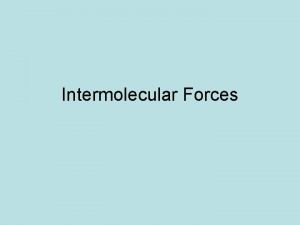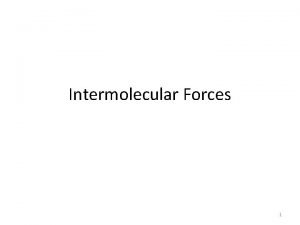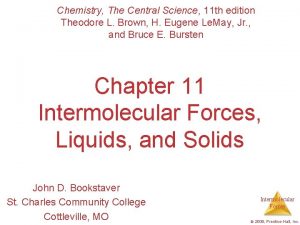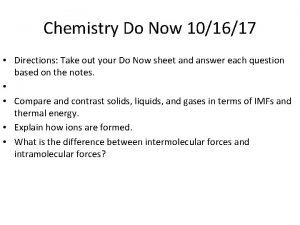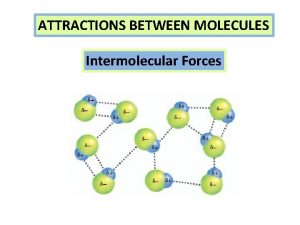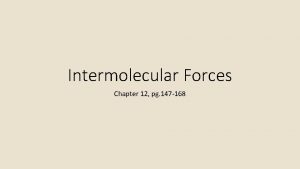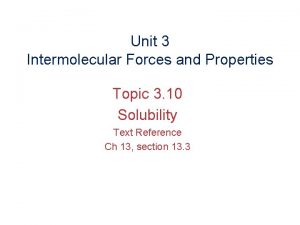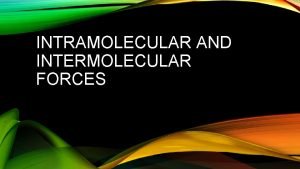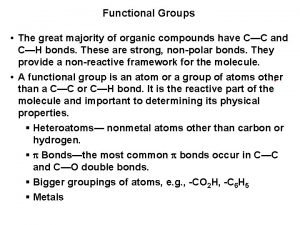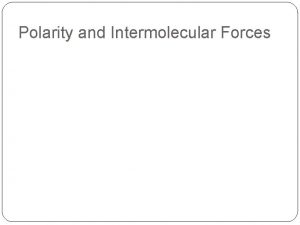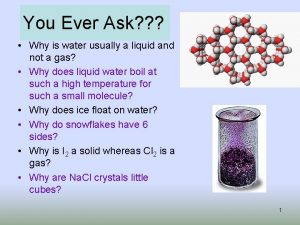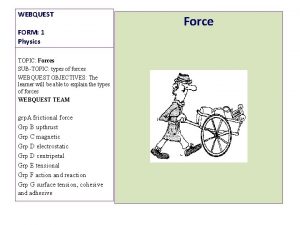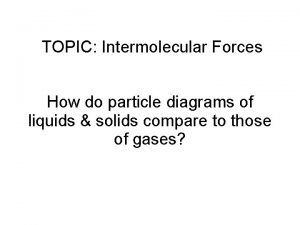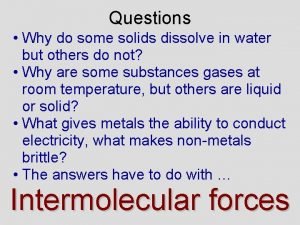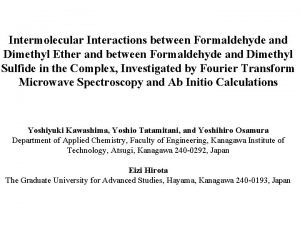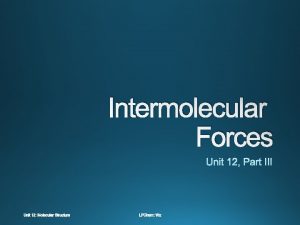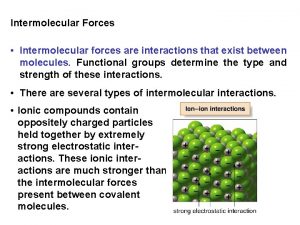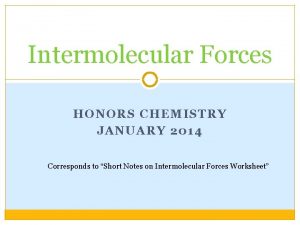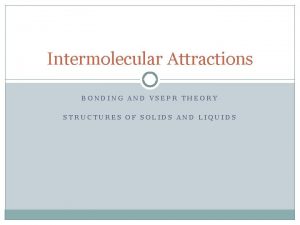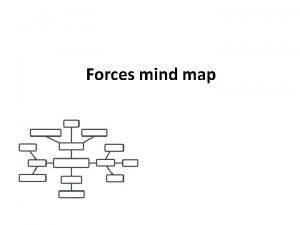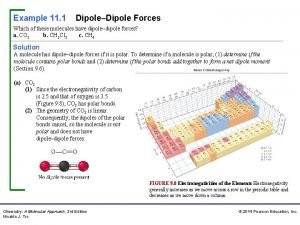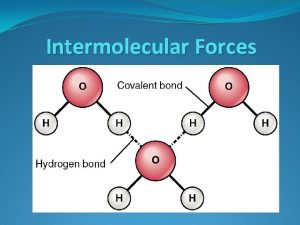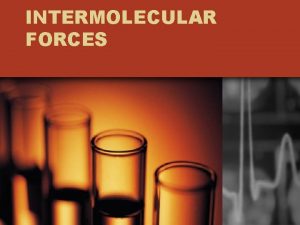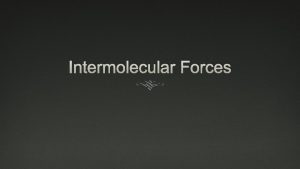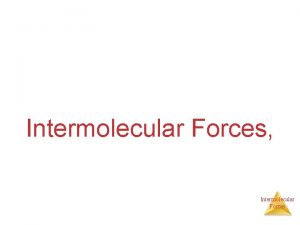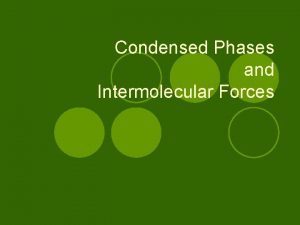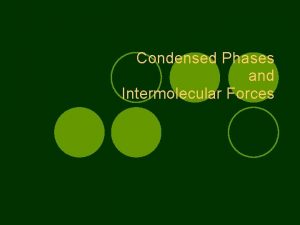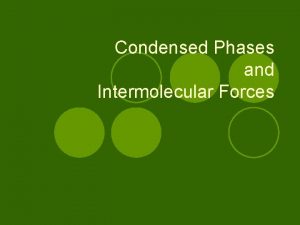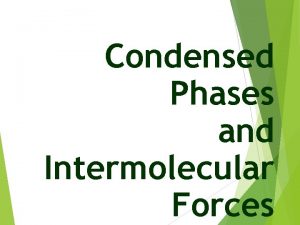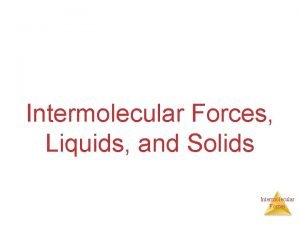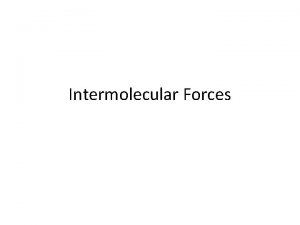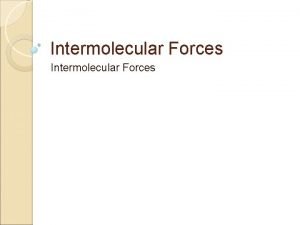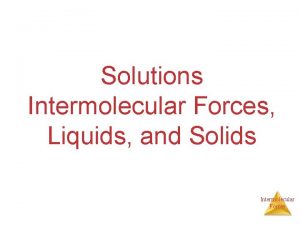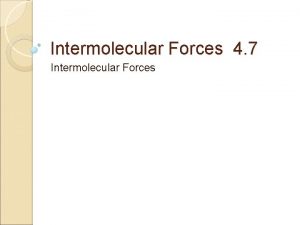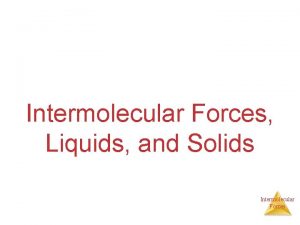Condensed Phases and Intermolecular Forces Lets look at













![Intermolecular Forces vs. Kinetic Energy IMF KE [this substance = a condensed phase (solid/liquid)] Intermolecular Forces vs. Kinetic Energy IMF KE [this substance = a condensed phase (solid/liquid)]](https://slidetodoc.com/presentation_image_h/eb137ba24668a1349eb950a9462cce0e/image-14.jpg)




















- Slides: 34

Condensed Phases and Intermolecular Forces

Let’s look at particle diagrams of liquids & solids and compare them to particle diagrams of gases

Describe & compare the relative positions and motions of particles in each of 3 phases:

The Question: Why do some substances exist as gases, some as liquids, and some as solids at room temp?

part of answer has to do with attractive forces between separate but neighboring molecules

2 broad categories of attractive forces come into play: INTRAmolecular forces of attraction 2. INTERmolecular forces of attraction 1.

Forces INTERMOLECULAR INTRAMOLECULAR Dispersion Covalent Dipole-Dipole Ionic Hydrogen Bonding Metallic

#1: Intramolecular Forces Intra means “within” Intramolecular bonding forces attractive forces are chem Definition: attractive forces that hold particles together in chemical bonds 3 types: ionic, covalent, or metallic bonds

# 2: Intermolecular Forces (IMF) (aka: van der Waals forces) Inter means “between” or “among” Intermolecular forces: attractive forces between neighboring molecules Intermolecular forces are weaker than Intramolecular forces

IMF: weaker than intramolecular (bonding) forces ≈ 5% to 15% of strength of intramolecular forces account for phase of matter at room temp strong weak IMF condensed phase (solid/liquid) IMF gas phase

IMF determine phase of matter phase is determined by: “competition” IMF and KE between strength of

If IMF are strong, substance will be solid or liquid at room temp strong attractive forces keep particles close together If IMF are weak, substance will be gas at room temp weak attractive forces allow particles to spread far apart & be free to move

It’s all a balancing act! KE IMF [this substance = a gas at room temperature]
![Intermolecular Forces vs Kinetic Energy IMF KE this substance a condensed phase solidliquid Intermolecular Forces vs. Kinetic Energy IMF KE [this substance = a condensed phase (solid/liquid)]](https://slidetodoc.com/presentation_image_h/eb137ba24668a1349eb950a9462cce0e/image-14.jpg)
Intermolecular Forces vs. Kinetic Energy IMF KE [this substance = a condensed phase (solid/liquid)]

since T is measure of average KE, changing T can change phase changing T changes average KE of particles T change can allow change in phase

3 types of IMF: 1. Dispersion forces 2. Dipole-Dipole forces 3. Hydrogen bonds

1. Dispersion Forces: Forces ● ● weakest IMF occur between non-polar molecules

dispersion forces & non-polar molecules • instantaneous and momentary change • electron cloud will fluctuate • results from motion of electrons due to attractive forces

Non-polar atoms/molecules non-polar means no poles non • can’t tell one end of atom/molecule from other end • electrons are evenly distributed • charge is evenly distributed • atom/molecule: symmetrical

Non-polar Atoms/Molecules: monatomic He, atoms: Ne, Ar, Kr, Xe, Rn 0 diatomic H 2, elements: N 2, O 2, Cl 2, F 2, I 2, Br 2 0 small symmetrical molecules: CO 2 , CX 4 0 carbon-hydrogen CH 4, C 2 H 6, C 3 H 8 molecules:

Dispersion Forces and Size larger the electron cloud, the greater the fluctuations in charge can be strength of attractive dispersion forces ↑ with increrasing molecule size increasing strength of dispersion forces: Rn > Xe > Kr > Ar > Ne > He I 2 > Br 2 > Cl 2 > F 2 C 8 H 18 > C 5 H 12 > C 3 H 8 > CH 4

2. • • Dipole-Dipole forces: forces intermediate IMF occur between polar molecules

What do you know about charge? Opposites Attract! this time, uneven distribution of electrons (charge) is permanent! examples: non-polar H 2 CH 4 polar HI CH 3 Cl

Polar Molecules: geometry NOT symmetrical (asymmetrical) uneven electron distribution permanent separation of charge has poles: one end partly (-) and one end partly (+)

neighboring molecules orient themselves according to their opposing attractive charges

3. • • • Hydrogen Bonding forces: forces strongest IMF subtype of dipole-dipole attractive forces attractive force occurs between H in one molecule and F, O or N in neighboring molecule H-F H-O or H-N

Hydrogen Bonding Force H-O N-H 0 this attractive force occurs between molecules with FON!!!

Hydrogen Bonding Force hydrogen bonding force is special subtype of dipole-dipole attractive forces F, O, and N are all small and electronegative strong electron attraction H has only 1 electron, so if being pulled away H proton is almost “naked” H end of molecule is always positive & F, O, or N end is always negative

Strength of Hydrogen Bonding Force fluorine most electronegative element, so H-F bonds are most polar and exhibit strongest hydrogen bonding attractive forces H-F > H-O > H-N

IMF vs. Physical Properties If strength of IMF then: boiling point melting point heat of fusion heat of vaporization while: evaporation rate boiling point melting point heat of fusion heat of vaporization evaporation rate

boiling point of N 2 is 77 K (-196˚C) IMF are very, very weak forces (dispersion)

Hydrogen bonding: • strongest IMF • influences physical props a great deal

IMF vs. Temp IMF more important as temp is lowered low temperature = low evaporation rate high temperature = high evaporation rate

Indicate type of IMF for each molecule: NH 3 • Ar • N 2 • HCl • HF • Ne • O 2 • HBr • CH 3 NH 2 • hydrogen bonding dispersion forces dipole-dipole forces hydrogen bonding dispersion dipole-dipole hydrogen bonding
 Look up to the left
Look up to the left Intramolecular forces vs intermolecular forces
Intramolecular forces vs intermolecular forces Intermolecular forces in a lava lamp
Intermolecular forces in a lava lamp Covalent bond intermolecular forces
Covalent bond intermolecular forces Intermolecular and intramolecular forces
Intermolecular and intramolecular forces Gecko feet facts
Gecko feet facts Intermolecular forces
Intermolecular forces Viscosity and intermolecular forces
Viscosity and intermolecular forces Intermolecular forces capillary action
Intermolecular forces capillary action Attraction
Attraction Pg 147
Pg 147 Unit 3 intermolecular forces and properties
Unit 3 intermolecular forces and properties Dispersion forces examples
Dispersion forces examples Electronegativity and intermolecular forces
Electronegativity and intermolecular forces Boiling point vs melting point
Boiling point vs melting point Intermolecular forces review
Intermolecular forces review Ch2cl intermolecular forces
Ch2cl intermolecular forces Webquest types of forces answers
Webquest types of forces answers Intermolecular forces
Intermolecular forces 3 types of intermolecular forces
3 types of intermolecular forces Types of intermolecular forces
Types of intermolecular forces How intermolecular forces affect solvation
How intermolecular forces affect solvation Intermolecular forces present in hbr
Intermolecular forces present in hbr Phthatic
Phthatic Dimethyl ether intermolecular forces
Dimethyl ether intermolecular forces Intermolecular forces symbol
Intermolecular forces symbol Intramolecular forces
Intramolecular forces Intermolecular forces strength
Intermolecular forces strength Van der waals attraction
Van der waals attraction Strongest to weakest intermolecular forces
Strongest to weakest intermolecular forces Intermolecular forces strongest to weakest
Intermolecular forces strongest to weakest Ch2cl intermolecular forces
Ch2cl intermolecular forces Hydrogen bond intermolecular forces
Hydrogen bond intermolecular forces Mind map about intermolecular forces
Mind map about intermolecular forces Ch2cl intermolecular forces
Ch2cl intermolecular forces





